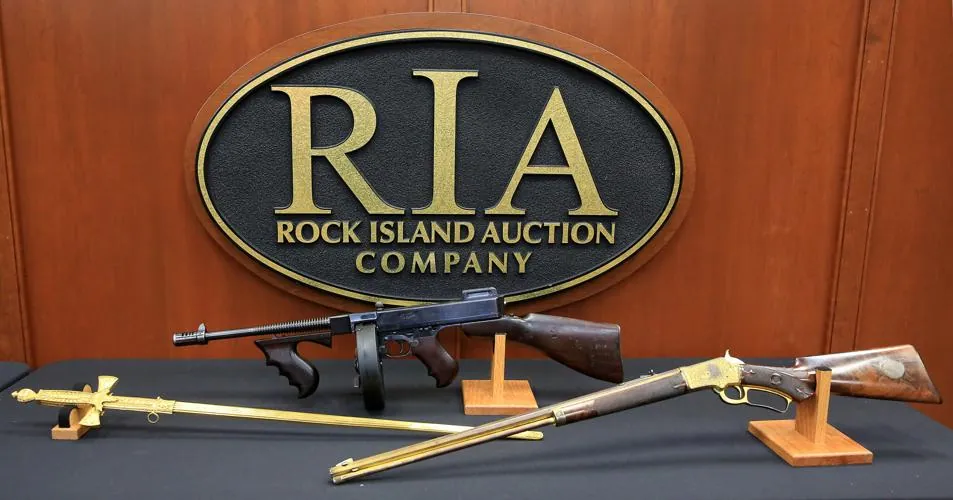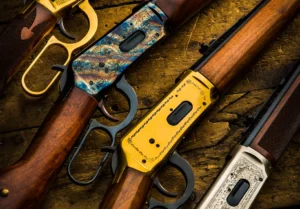The Rock Island Auction Company (RIAC) is a name that resonates with gun collectors worldwide.
Founded in 1993, this Illinois-based auction house has carved a niche in the firearms auction industry.
RIAC has auctioned a wide array of items, from antique guns to modern firearms. It has set numerous world records for the highest prices realized at a gun auction.
This article delves into Rock Island Auction’s history, exploring its significance in the gun collectors community and the types of firearms typically auctioned.
We will also discuss notable events such as the Rock Island Auction lawsuit. This neutral overview aims to comprehensively understand this prominent auction house.
Whether you’re a seasoned gun collector, history enthusiast, or simply curious, this article promises to be enlightening.
The Founding of Rock Island Auction
The story of Rock Island Auction begins with its founder, Patrick Hogan.
In 1993, Hogan established the company with a vision to create a world-class platform for firearms auctions.
Over the years, his dedication and passion for firearms have propelled RIAC to the forefront of the industry. Today, it is recognized as one of the leading auction houses specializing in firearms.
The company’s headquarters in Rock Island, Illinois, has become a hub for gun collectors. Numerous auctions are held here each year, attracting enthusiasts from around the globe.
From its humble beginnings to its current prominence, the journey of Rock Island Auction is a testament to Hogan’s vision and the team’s commitment to excellence.
Rock Island Auction’s Place in the Gun Collectors Community
Rock Island Auction Company (RIAC) is significant in the gun collectors community.
Its reputation for auctioning a wide range of firearms, from antique to modern guns, has made it a collector’s go-to destination.
RIAC’s auctions are not just commercial events. There are also social gatherings where enthusiasts share their passion for firearms.
The company’s auctions include:
- Premiere Auctions: These flagship events showcase the rarest and most collectible firearms.
- Sporting & Collector Auctions: These auctions feature a wide range of firearms suitable for various collecting interests and budgets.
- Arms & Accessories Day Auctions: These events offer firearms accessories and other related items.
Through these auctions, RIAC has fostered a vibrant community of collectors. It continues to play a pivotal role in shaping the landscape of gun collecting.
Notable Auctions and World Records
Over the years, Rock Island Auction has hosted numerous notable auctions. These events have often set world records for the highest prices realized at a gun auction.
One such event was the sale of the Robert M. Lee Collection. This collection, known for its exceptional quality and rarity, fetched record-breaking prices.
Another memorable auction was the sale of the Putnam Green/Sycamore Collection. This event featured some of the most sought-after antique firearms, attracting collectors from around the world.
These record-setting auctions underscore Rock Island Auction’s position as a leading auction house in the firearms industry. They also highlight the enduring appeal and value of rare and antique guns.
The Auction Process at Rock Island Auction
The auction process at Rock Island Auction is designed to be transparent and user-friendly. It begins with the consignment of firearms, where sellers bring their items to be appraised and listed for auction.
The company’s team of experts carefully evaluates each item. They assess its condition, authenticity, and market value. This ensures that all items are properly valued and represented in the auction.
Potential buyers can review detailed catalogs and online listings before the auction. These resources provide extensive information about each item, including its history, condition, and estimated value.
The auctions themselves are lively events, with bids coming in from the auction floor, phone, and online. Here’s a brief overview of the auction types:
- Premiere Auctions: These are the flagship events, showcasing the rarest and most collectible firearms.
- Sporting & Collector Auctions: These auctions feature a wide range of firearms, catering to both seasoned collectors and newcomers.
- Arms & Accessories Day Auctions: These events focus on firearms accessories and related items, offering something for every enthusiast.
After the auction, Rock Island Auction handles the payment and delivery process, ensuring a smooth transaction for both buyers and sellers.
Rock Island Auction Lawsuit: A Neutral Overview
Rock Island Auction has faced legal disputes in its history, most notably the Rock Island Auction lawsuit. This case involved allegations of misrepresentation and breach of warranty, causing ripples in the collectors’ community.
The lawsuit was a significant event, not just for Rock Island Auction, but for the entire auction industry. It highlighted the importance of transparency and accurate representation in auction listings, reinforcing the need for rigorous appraisal and authentication processes.
While the lawsuit was a challenging period for Rock Island Auction, it also served as a catalyst for change. The company has since strengthened its commitment to transparency and accuracy, ensuring that all items are thoroughly evaluated and accurately described.
It’s important to note that this overview is neutral and factual. Legal disputes are complex, and this summary does not delve into the specifics of the case or its outcome.
The Significance of Antique Guns in Rock Island Auctions
Antique guns hold a special place in Rock Island Auctions. These pieces are not just firearms, but historical artifacts that tell stories of the past. They are highly sought after by collectors and historians alike.
From flintlock pistols to Civil War muskets, the range of antique guns auctioned is vast. Each piece is meticulously appraised for its authenticity, condition, and historical significance. This rigorous process ensures that only genuine and valuable items make it to the auction block.
The high demand for antique guns at Rock Island Auctions reflects the broader trend in the collectors’ market. These items are prized for their craftsmanship, rarity, and the historical periods they represent.
In conclusion, antique guns are a cornerstone of Rock Island Auctions. They contribute significantly to the auction house’s reputation as a leading platform for firearm collectors.
The Role of Rock Island Auction in Preserving History
Rock Island Auction plays a crucial role in preserving history. By auctioning off historically significant firearms, it helps keep the past alive. Each auctioned item has a story to tell, from guns owned by historical figures to those used in significant events.
The auction house also provides extensive information about each item’s history. This educational aspect of their work helps to inform the public about the historical and technical aspects of firearms. It’s not just about selling guns, but also about sharing knowledge and promoting responsible collecting.
In essence, Rock Island Auction is more than just an auction house. It’s a custodian of history, ensuring that important artifacts are preserved and appreciated by future generations.
Rock Island Auction’s Adaptation to Technology and Online Bidding
Rock Island Auction has embraced technology to modernize its operations. The company’s website offers a user-friendly platform for online bidding, making it accessible to a global audience.
Live-streaming auctions have also become a norm. This allows enthusiasts from around the world to participate in auctions without having to be physically present. In this way, Rock Island Auction continues to innovate, ensuring it remains a leader in the firearms auction industry.
The Future of Rock Island Auction and the Firearms Auction Industry
The future of Rock Island Auction looks promising. The company continues to adapt to market trends and the evolving interests of collectors. This adaptability is key to its ongoing success.
The broader firearms auction industry also shows growth potential. As long as there are collectors interested in firearms, there will be a market for auctions. Rock Island Auction is well-positioned to continue playing a significant role in this industry.
How to Participate in a Rock Island Auction
Participating in a Rock Island Auction is straightforward. The company offers both in-person and online bidding options, making it accessible to a global audience.
To participate, follow these steps:
- Register on the RIAC website.
- Review the auction catalog.
- Place your bids either in person or online.
Remember, each auction has its own set of rules. It’s important to familiarize yourself with these before participating. This ensures a smooth and enjoyable auction experience.
Conclusion: The Lasting Impact of Rock Island Auction
Rock Island Auction has left an indelible mark on the firearms auction industry. Its commitment to authenticity, transparency, and customer service has set a high standard for other auction houses.
The company’s role in preserving history by auctioning antique and historically significant firearms is commendable. It has helped keep the stories of these items alive, contributing to the rich tapestry of our shared history.
As we look to the future, Rock Island Auction is poised to continue its leadership in the industry. Its adaptability and dedication to its craft ensure its ongoing relevance and success.






